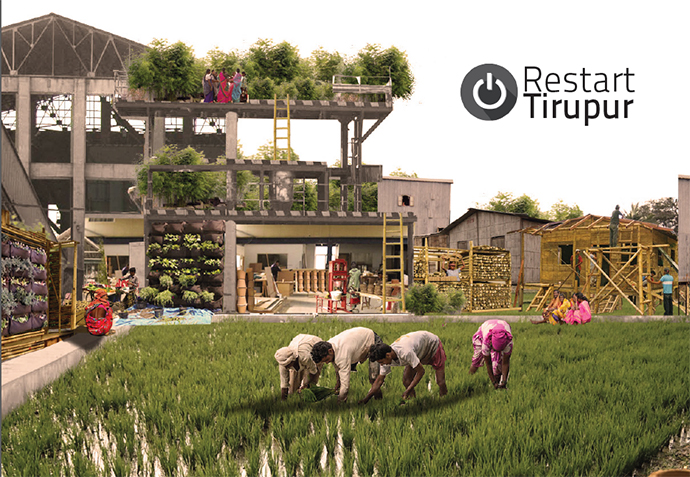Urban SOS: one project at a time
Finalists Emily Saunders and Michelle Zucker presenting at New York’s Center for Architecture.
In the design world, competitions are a dime a dozen. As Rem Koolhaas has lamented, design is the only profession where so much energy is spent on work that exists only in books or blogs, the fruit of long under- or unpaid hours that may look beautiful and inspire the mind, but usually remains unbuilt.
It’s against this backdrop of misspent though admirable effort that AECOM organizes the Urban SOS open ideas competition. Urban SOS is probably where we get closest as a company to articulating a point of view about the design profession (and process). We believe passionately that successful design is not the purview of just a single discipline or frame of mind, which is why we use this competition to instill a more broad-minded approach among the emerging generation of design talent. To win, a beautiful design response or a clearly rational plan isn’t enough. Submissions are judged by their creativity and feasibility and crucially, they are evaluated by how cross-disciplinary and multi-dimensional they are.
Embracing Rem’s critique of the unrealized competition, we have also now committed ourselves to helping advance the wining scheme, so at least one project isn’t done simply to line one’s portfolio. The 2011 Urban SOS: Water competition’s winning design of waterfront spaces in the slums of the Indonesian city of Banjarmasin (pop. 625,000) has been built with assistance from AECOM. We’re hoping that this year’s winning project in the Tamil city of Tirupur (pop. 445,000) will soon be as well. Proposed by Michelle Zucker, a landscape architecture student at Penn State and Emily Saunders, an architecture student at Cal Poly San Luis Obispo, Restart Tirupur imagines a semi-formal community independent of globalized industries and cycles of production in previously vacated textile clusters that for several years have lay dormant.
The 2014 Urban SOS brief – Towards a New Industry – asked design students to tackle an economic problem. Student teams were asked to propose design projects that re-animate an abandoned or underutilized industrial space or place of production within a city. Responses could range from macro to micro and had to pair a design response with a commercial awareness. As an interdisciplinary practice engaged with shaping cities around the world, this topic at the intersection of design and economics is of particular interest to us.
Restart Tirupur takes a global problem and gives it a very local response that is easily scale-able.
Michelle and Emily’s vision for restarting Tirupur will provide workers forced to migrate to the city from the nearby countryside with the tools to obtain clean water, self-grown food and native materials for building resilient shelters. It’s a global problem that needs a very local solution. The boom of the textile industry in Tirupur has devastated the environment via discharge of effluents into the city’s Noyyal River. In 2011, due to lobbying from farmers in the area, all 729 textile clusters were closed down and prevented from reopening until sustainable means of processing effluents were implemented. Michelle and Emily’s scheme provides a plan to start reopening them but with a new economic and social function. Their project reorients the textile clusters as water filter systems and start-up community factories. They identified a pilot project, which can be realized in cooperation with the group Potters for Peace.
Michelle and Emily were one of four teams presenting before the jury and a packed hall at the Center for Architecture on September 4, 2014. Three other finalists joined them to battle it out for the top spot:
- Erica Chladová, a landscape architecture postgraduate at TU Delft, who proposed a renewable bio-mass landscape on the site of a Dutch state coal mine that is to be closed in the run-up to the Netherlands’ 2050 transition to a carbon neutral energy system;
- Skye Sun, an architecture MA candidate at the Royal College of Art, who proposed to take a series of now defunct limestone mine tunnels in the English Black Country city of Dudley and turn them into a solemn place of burial as Britain will soon run out of space to lay its dead to rest;
- Chris Dove, an architecture postgraduate at the Glasgow School of Art, who proposed to make right the overzealous slum clearance of previous generations in a post-industrial Copenhagen block with a design that was beautifully and artfully presented.
Three weeks ago in Beijing, one of 30 AECOM juries.
All four finalist schemes were incredibly strong and their designers should be proud of their achievement in getting to the top four. They emerged from hundreds of projects that were reviewed by multi-disciplinary juries in 30 AECOM offices/studios around the world, from Abu Dhabi to Pretoria. Over one week in August, the groups met in a unique global ‘super-jury’ consisting of more than 250 AECOM designers, planners and engineers who whittled the entries down to the final four.
Those four teams were then flown to New York to present in an evening charrette before a finalist jury of my colleagues, architects Bill Hanway and Ross Wimer, landscape architects Joe Brown and Jacinta McCann, urban designer Stephen Engblom and civil engineer Jane Chmielinski, AECOM’s chief operating officer. They were joined by Jeffrey Johnson, director of the China Lab at Columbia University Graduate School of Architecture, Planning and Preservation, Nellwyn Thomas of Etsy and Alexis Michael of property developer Hines.
Re-inspired as usual by the conclusion of our fifth annual Urban SOS program, we look forward to next year and thank everyone for their involvement.
 Daniel Elsea (daniel.elsea@aecom.com) is creative director for AECOM’s Buildings + Places group.
Daniel Elsea (daniel.elsea@aecom.com) is creative director for AECOM’s Buildings + Places group.









